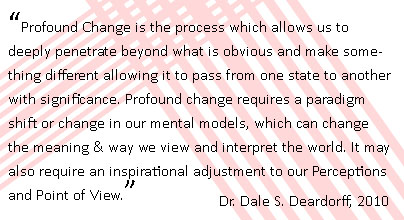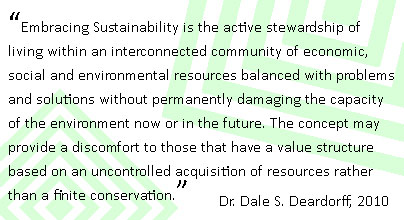|

Strategic Leadership for Embracing Organizational Complexity
The Leaders of today are challenged with the need to provide the vision and direction for the growth and success of an organization. The path is faced with dilemmas, hard choices, paradoxes and tough trade-offs. In general, our work has become more, dynamic, complex and interdependent in organizations. Additionally they are forced to embrace and successfully deal with transparent change while being intuitive and authentic. This change requires skills, and tools for strategy formulation, flexible implementation, organizational agility, and synergies to provide a sense of positive direction.
Strategic leaders apply many of the basic leadership skills and actions they mastered as organizational leaders; however, strategic leadership requires additional skills that are more integrated, complex, and timely for creating strategic actions. Strategic leaders have a passion and desire to allow the organization and its members to move forward in a positive direction. They allow their organizations to anticipate, prepare, and position others for the future by the mobilization and focus of resources and energy on things that can create a strong competitive advantage and future economic value.
Strategic people think and act before they have to, before they are forced by internal circumstance or external events, to take a defensive position against unpredicted change. Leaders must be attuned to the signals that provide them with anticipated insight about the needs and wants of their team members, management teams, stakeholders, and suppliers. As a leader, you must know who your customers are and why they have chosen you and your organization over a competitor.
Additionally, you must anticipate what they will need from you in the future and how your environment is changing and evolving. A strategic leader must also carefully consider the organization's competitors; know the products they can offer and how prospective customers view them. This view is a delicate balance between being perceived as confident without the negative appearance of being arrogant.
In most scenarios, our society is addicted to short-term traditional thinking, and most of us are caught in this trap in our daily routines focused only on resolving the immediate problems. Too many people are trapped in this stimulus-response mode, acting only on their immediate concerns without a window into the impacts of them on the future.
We put out fires but fail to think about the longer-term impact of our leadership actions, behaviors and attitudes. Even worse, we continue to do what we've always done, even when dynamic situations cause those solutions to be irrelevant in today's reality. We ignore and overlook opportunities failing to see pro-active decisions, actions and ideas from a strategic perspective. This means that many times our only "goal" is to survive today looking at the next crisis as it appears in the rear view mirror.
The true demonstration of strategic leadership is in the charter of creating a new leadership model that ensures a sustainable future. To accomplish this model, you must build it one piece at a time. The first step requires starting with the establishment of a core group of forward minded thinkers. These strategic thinkers need to establish a vision and community of values which focus on awareness and anticipation for problem solving. They will need to embrace increasing uncertainty, growing ambiguity and increasing complexity due to free flowing communication. Strategic leadership encompasses, but is not limited to the skills of strategic planning, strategic management, strategic perceptions (Point Of View) and strategic alliances & relationships.
Strategic Planning:
Strategic planning requires a flexible mindset to define your strategy or direction, followed by the art of making decisions. Many times these decisions are related to allocating the necessary resources to pursue this strategy, including capital and people. A Strategic Leader blends these skills of thinking, acting and influencing as a cycle of organizational learning. Realistically they are responsible for planning the path, executing the path and seeing the results. To maintain momentum in this cycle requires a flexible and adaptive framework and structure which can be adapted to any organization. My recommendation is to use the “Shewhart Cycle” model for Plan-Do-Check-Act. This 4-step iterative management model allows a continuous cycle for “checking” implementation of actions and their ultimate strategic impact.

Shewhart Plan-Do-Check-Act Model
Strategic Plan – The 1st step is to “Plan” or anticipate what the proposed action or objectives will accomplish. It also identifies and clarifies what the tangible impacts and performance characteristics will be.
Strategic Do – The 2nd step is to “Do” the actual action or event. This implementation of action should be conducted as closely as possible to what was planned in step 1. The process of “Do-ing” is a representational characteristic of your efficiency and effectiveness in completing tasks.
Strategic Check – The 3rd step is to quantify, qualify, and measure the new processes. You must compare the results against the expectation to evaluate any differences. It is important to review and understand the actions that were taken and the short and long term results they created.
Strategic Act – The 4th and final step is to logically analyze the differences to determine their cause. If the actions from the “Do” step are not logically linked to the results that were achieved, then there is a logical strategic disconnect. The ability to repeat and refine the process creates a strategic cycle to understand if you’re moving in the correct direction, driven by what your organization is actually executing.
This Strategic Planning model and philosophy will allow strategic leaders the ability to ask themselves and those around them:
- What are the organizations top three strategic initiatives for this year?
- Do we understand how these were created?
- Do we understand how these were executed?
- And what is the impact to our organization?
If everyone in your organization can answer yes to the first 3 questions and identify them, you have a process in place that can check your present position and anticipate what is ahead of you, by understanding the factors of the organizational environment (some factors include; yourself, your competitors and partners).
If the answer is no, or there is a pause and lack of response, you may have a lack of functional Strategic Management. This lack of response means you may also have a failure in your organization’s ability to question implicit beliefs, structures and mindsets to synthesize and analyze your future.

Strategic Management:
Strategic management is an ongoing process that evaluates and controls the business and the industries in which the company is involved. It assesses your competitors and establishes goals and strategies to meet your existing and potential stakeholders. This Strategic Thinking process also reassesses each strategy regularly to determine how it has been implemented. A comprehensive review of the strategic environment is necessary to clearly understand your organization's future. The result of the review and assessment reflects if a strategy has been successful, or if it needs to be replaced by a new strategy.
Measuring the effectiveness of your organizational strategy requires a collaborative overview of multiple points of view. By conducting a SWOT analysis you can achieve this. The old story about the two stonemasons’s working side by side where when asked what they were doing; one said “I’m cutting stone”. The other man said “I’m building a great cathedral”. This example demonstrates that a difference in strategic perspective needs to be acknowledged and shared because both sides of the story are true. Two people independently will rarely come-up with the same final version of a SWOT analysis, so make sure it is constructed as collaborative process that is driven to consensus for a bounded series of results.
A SWOT analysis as seen in the figure below, is an important strategic tool which allows you to evaluate your organizational strategic perspective by understanding the Strengths, Weaknesses, Opportunities, and Threats involved in your organizational goals, objectives and resources. These include the internal and external factors that are favorable and unfavorable to achieve those objectives.
To conduct a SWOT analysis, you would gather the appropriate people who can clarify, define and complete the information required in each area of the matrix. Remember that Internal Factors can be controlled by you; external factors can only be influenced by you.

SWOT Matrix
Strengths – Strategic characteristics of the organization or team that give it an advantage over others in the industry. What makes your characteristic more powerful in comparison to someone else’s?
Weaknesses – Strategic characteristics that place your organization at a disadvantage relative to others. Be honest and identify the shortcomings. Strengths and weaknesses are not necessarily opposites, but they can be.
Opportunities - External Strategic chances to make greater sales or profits in the current environment. Look for positives that can help make your organization more successful. These may not exist yet but can be conceptualized as ideas.
Threats - External Strategic elements in the current environment that could cause problems, issues or concerns for your business. Threats may not happen but there is a possibility that they could.
Once a SWOT Matrix is completed, you can understand the strategic implications of the analysis by recognizing that the internal areas (Strengths & Weaknesses) can be strategically managed and developed by you. The external areas (Opportunities & Threats) cannot be controlled by you but can be strategically managed by risk mitigation and an active opportunity program.
All of the information or statements contained in a SWOT analysis should be used for strategy formulation. Documenting this information in the 2 X 2 matrix without taking it to the next level is a waste of time and effort. You must use the analysis information to establish or create new Strategic Goal Statements.
In the sample SWOT figure above:
The Internal Strengths line up vertically with the external Opportunities. It represents the best fit between the company's resources and the options available in the external market. Strategically blending or merging these together allows you to create an area where these identified opportunities should be refined into SMART Goals.
The Internal Weaknesses line up diagonally relative to the external Opportunities. Strategies in the connection between these areas would address the choice of either improving the Weaknesses to turn them into Strengths, or growing capabilities to create new Opportunities
The Internal Strengths line up diagonally relative to the external Threats. Strategies in the connection between these areas may allow you to transform the external Threats into internal Opportunities by changing the use of your internal resources or Strengths.
The Internal Weaknesses line up vertically with the external Threats. This is the worst possible scenarios for your organization. Strategies in the connection between these areas must be carried on a Strategic Threat matrix as illustrated below.
Managing Strategic Threats requires the creation of a simple 5 X 5 matrix which should include one axis for scaling the probability (very low, not probable, probable, high probability and very high probability) and another axis for the seriousness (minor, significant, sever, major, catastrophic) of the Threat being reviewed. These factors once mapped can quantify strategic information for you and allow the creation of actionable results.

Sample Threat Matrix
The Threat matrix allows you to create a single page, quick view of the probable threats mapped in terms of likelihood or probability ranked from 1 (very low probability) to 5 (very high probability). Additionally you map them by the severity of the consequence from minor to catastrophic. Once you have mapped your strategic Threat’s, in the appropriate Threat matrix colored box the potential impact is immediately understood.
Extreme Threats: The Threats that fall in the cells marked with red color are the Threats that are most critical and should be addressed on a high priority basis.
High Threats: Denoted with an orange background in the Threat assessment matrix, also call for immediate action or substitution strategies.
Medium Threats: If a Threat falls in one of the yellow cells, it is best to take some reasonable steps and develop Threat management strategies at a later time, they can usually be avoided with smart thinking and logical planning.
Low Threats: The Threats that fall in the green cells and can be ignored as they usually do not pose any significant problems. By actively and aggressively managing the Threats to your organization you can create a baseline strategic Threat profile which can be quickly assessed and managed.
Managing Strategic Opportunities requires the creation of an Opportunity Idea matrix similar to the simple figure below. It should include an axis for probability (ease of implementation) and another for attractiveness (relative impact on the business).

Sample Opportunity Idea Matrix
The Opportunity Idea matrix contains 4 areas that the ideas are mapped into which meet the following criteria for implementation.
High Impact/Easy Implement Opportunities - These ideas represent the best return on your efforts, in terms of taking your business where you want it to go to with the least effort, and probably have the greatest chance of success. The payback is high and should be strategically the first ideas developed.
Low Impact/Easy Implement Opportunities - These ideas represent a very good ROI for your business but have a low impact on your business. The payback is good and these ideas may seem like “Low hanging fruit”. Strategically these ideas should be developed but only after the High Impact ideas.
High Impact/Not so easy to Implement Opportunities - These ideas are worth the effort but they will take additional refinement and development before they are usable. The majority of your revolutionary business solutions can come from this area of ideas. Strategically these ideas must be developed in parallel with the High Impact and Easy to implement ideas but will require new business plans, additional funding and time before they will be implementable.
Low Impact/Not so easy to Implement Opportunities - These ideas will take you extensive time and effort to get developed and implemented. The payback is low and should be strategically the last ideas developed. Strategically these ideas may be valuable to hold as trade secrets or intellectual property to prevent competitors from advancing, but can also be patented and/or sold to non-competitors to increase revenue.
By using the tools previously identified to create a SWOT analysis, Threat matrix and Opportunity Idea matrix you can actively create a valuable strategic mapping of your organizational position. These tools require strategic thinking, attention to the big picture and an understanding of the complexity of your technologies, capabilities and competitors positions. Strategic thinking is adaptive and keeps an organization relevant by asking “are we doing the right things?”

Strategic leadership:
Strategic leadership encompasses the use and implementation of all aspects of these previously described tools. It is a dynamic and flexible continuous learning process that includes a disciplined dimension of self-learning through discovery. You must foster and inspire strategic leadership in others while creating an environment and culture of trust.
This requires embracing the skills of critical thinking and actions in two distinct time domains; the present reality and the future focus. The journey of Strategic Leadership requires questioning implicit beliefs and assumptions about the organization and your competitors.
Critical thinking requires linear and non-linear logic based on the skills of scanning, visioning, reframing and systems thinking. Strategic leaders are change agents that help spearhead grassroots transformations up into the organizational hierarchy to help create new strategic direction statements. You need a complete and thorough knowledge of your organizations sustainable capabilities and profound implications.
Strategic Leaders are able to dream a vision and have the passion to communicate that vision with the transparent ability to inspire people in a positive way to reach high levels of performance and success.
- Walt Disney started a comic strip with Mickey Mouse before sound and motion were known to most people. His strategic vision, planning, management and performance execution has allowed Disney to become one of the largest multidimensional entertainment enterprises.
- Bill Gates bought MS Dos to power IBMs new PC’s, and as a computer developer and entrepreneur became a pioneer who grew Microsoft Corporation into one of the largest and most influential companies in the personal computer industry.
- Sam Walton started a five and ten in Bentonville, Arkansas in 1950 with a $20,000. loan and $5,000. of his own money. Then in 1962 founded Wal-Mart first discount store which has now revolutionized the retailing business by providing customers with associates who greet them, look them in the eye, and ask to help.
These Strategic Leaders have all revolutionized their industries in a positive way by influencing the formation of their most desirable futures. Quinn (2004) suggests that the foundation of leadership is not behavior, competencies, techniques, or position; but rather that, the foundation of leadership comes from who we are, or the “person within” the leader.
Dale S. Deardorff
|










